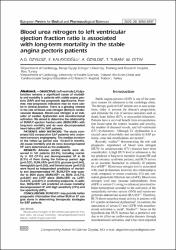| dc.contributor.author | Özyıldız, Ali Gökhan | |
| dc.contributor.author | Kalaycıoğlu, Ezgi | |
| dc.contributor.author | Özyıldız, A. | |
| dc.contributor.author | Turan, Turhan | |
| dc.contributor.author | Çetin, Mustafa | |
| dc.date.accessioned | 2023-01-09T07:15:50Z | |
| dc.date.available | 2023-01-09T07:15:50Z | |
| dc.date.issued | 2022 | en_US |
| dc.identifier.citation | Özyıldız, A. G., Kalaycıoğlu, E., Özyıldız, A., Turan, T., & Çetin, M. (2022). Blood urea nitrogen to left ventricular ejection fraction ratio is associated with long-term mortality in the stable angina pectoris patients. European review for medical and pharmacological sciences, 26(24), 9250–9257. https://doi.org/10.26355/eurrev_202212_30678 | en_US |
| dc.identifier.issn | 1128-3602 | |
| dc.identifier.uri | https://doi.org/10.26355/eurrev_202212_30678 | |
| dc.identifier.uri | https://hdl.handle.net/11436/7364 | |
| dc.description.abstract | OBJECTIVE: Left ventricle (LV) dysfunction remains a significant cause of morbidity and mortality in patients with stable angina pectoris (SAP) and has prognostic significance. However, new prognostic indicators may be more useful in clinical practice. There is a growing interest in the role of blood urea nitrogen (BUN) in cardiovascular diseases. Blood urea nitrogen is an indicator of cardiac dysfunction and neurohormonal activation. We aimed to determine the relationship of BUN/LV ejection fraction ratio (BUNLVEFr) with long-term mortality and de novo decompensated heart failure (HF) in SAP patients. PATIENTS AND METHODS: The study comprised 603 consecutive SAP patients who underwent coronary angiography. The median duration of the follow-up period was 112.6±17.8 months. All-cause mortality and de novo decompensated HF were determined as the endpoints. RESULTS: Adverse cardiac events were observed in 141 patients (23.3%), including mortality in 103 (17.1%) and decompensated HF in 38 (6.3%) of them during the follow-up period. Age (p=0.027), BUNLVEFr (p=0.001), glucose (p=0.043), hemoglobin (p=0.035), and Gensini score (p=0.012) were found as independent predictors of mortality and decompensated HF. BUNLVEFr was superior to BUN alone (BUNLVEFr vs. BUN: Z=5.715, p<0.001) and LVEF alone (BUNLVEFr vs. LVEF: Z=4.075, p[removed]29 predicted all-cause mortality/ decompensated HF with high sensitivity (78%) and low specificity (68%). CONCLUSIONS: BUNLVEFr may provide better prognostic information than either BUN or EF can give alone in determining therapeutic strategies for SAP patients. | en_US |
| dc.language.iso | eng | en_US |
| dc.publisher | Verduci Editore | en_US |
| dc.rights | info:eu-repo/semantics/openAccess | en_US |
| dc.subject | All-cause mortality | en_US |
| dc.subject | Blood urea nitrogen to left ventricular ejection fraction ratioBlood urea nitrogen to left ventricular ejection fraction ratio | en_US |
| dc.subject | Decompensated heart failure | en_US |
| dc.subject | Stable angina pectoris | en_US |
| dc.title | Blood urea nitrogen to left ventricular ejection fraction ratio is associated with long-term mortality in the stable angina pectoris patients | en_US |
| dc.type | article | en_US |
| dc.contributor.department | RTEÜ, Tıp Fakültesi, Dahili Tıp Bilimleri Bölümü | en_US |
| dc.contributor.institutionauthor | Özyıldız, Ali Gökhan | |
| dc.contributor.institutionauthor | Özyıldız, Afag | |
| dc.contributor.institutionauthor | Çetin, Mustafa | |
| dc.identifier.doi | 10.26355/eurrev_202212_30678 | en_US |
| dc.identifier.volume | 26 | en_US |
| dc.identifier.issue | 24 | en_US |
| dc.identifier.startpage | 9250 | en_US |
| dc.identifier.endpage | 9257 | en_US |
| dc.relation.journal | European Review for Medical and Pharmacological Sciences | en_US |
| dc.relation.publicationcategory | Makale - Uluslararası Hakemli Dergi - Kurum Öğretim Elemanı | en_US |


















